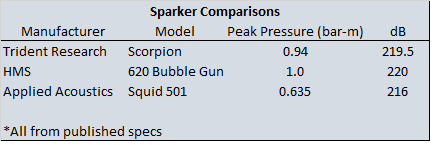News & Articles
How can I best compare sparker sources?
.png)
"How can I best compare sparker sources?"
We asked that question of Trident Research, the manufacturer of the Scorpion P-Wave Sparker Source. Brian Roderick, the product engineer, sent us this reply: "I know some people want to know what the stored energy of the unit is, due to other manufacturers providing this information, but it does not completely translate into acoustic output. There are too many other factors in play (how the power is switched, electrode design, etc.) that change the peak pressure of the output. I think our best way to tell people about the output of the Scorpion unit is to compare it to other sources that document their acoustic output pressure correctly. The acoustic output power of the Scorpion is documented in the Owner’s Manual as a peak pressure of 0.94 bar-m. These are the units that are generally used in the acoustics field for source level and also used by the other sound sources like the HMS-620LF Bubble Gun and the Applied Acoustics Squid 501 that is a 6” diameter sparker with four electrode tips. This is really the only way to compare sound sources and get the information the customer is really looking for (ie; How loud is the source?). "

"How far away will I be able to see the signal from the source?"
That's hard to say, of course, because it's going to be very dependent on the subsurface soil/rock types. Rather than make some kind of predictions, it might be better to simply point out an example where the prototype of the Scorpion was used to help map coal seams in Wyoming. The boreholes were 400' apart and a signal was still very measurable.
Here is a link to a paper presented at SAGEEP on that project: